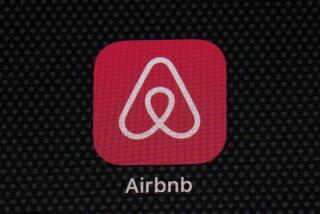Watching Rates as Detroit Hands Off Its Rental Outlets
- Share via
Item: In October 1996, HFS Inc., the world’s largest franchiser of hotels and real estate, buys Avis Corp. for $800 million, and as part of the deal General Motors sells its 29% stake in the rental-car company.
Item: In January 1997, Team Rental Group, a Daytona, Fla.-based franchisee of rental-car outlets, buys Budget for $350 million. The seller is Ford Motor Co.
Item: Auto industry authorities say Chrysler has been looking to sell its two rental companies, Dollar Rent-a-Car and Thrifty Car Rental Systems. And Travel Weekly has reported that Ford is “reviewing options” for Hertz Rent a Car, which it owns.
Meanwhile, also in January, Republic Industries, on a rampage of buying car dealerships and other auto-related business, agrees to buy National Car Rental System Inc. for $600 million. Just months before, Republic bought Alamo for $625 million. Together the purchases make Republic the second-largest car-rental chain in the country, ahead of Avis, behind only Hertz.
After spending a decade as a sort of stepchild to America’s biggest auto manufacturers, this country’s rental-car industry suddenly seems to be in new hands. So what does this mean for the travelers who are these companies’ customers?
Many industry veterans say rental-car companies will be under new pressure to boost revenues, pressure that could lead to price boosts that have been threatened for years.
But consumers have a highly competitive marketplace on their side. Just as rental-car companies’ fear of losing market-share has kept prices relatively flat for the last few years, it may hold the new owners in check too--at least for a while.
“The manufacturers got into the business [in the 1980s] when they really needed a conduit for their new cars,” recalls Jan Armstrong, executive vice president of the American Car Rental Assn., which represents about 2,000 U.S. car rental companies, including all the largest companies except Hertz.
“Then the market for new cars changed [for the better], and the manufacturers found that they could sell more of their cars directly to the public,” Armstrong says. As a result, car manufacturers over the last several years have reduced the number of cars they pass on to rental-car companies (known as “program” cars) and made the terms less appealing.
That in turn caused the car rental companies to keep their vehicles in circulation longer. The average vehicle from a major rental-car company is now likely to spend a year in service, accumulating 20,000 to 30,000 miles in cases of heavy use. Industry authorities say that under the market conditions of four years ago, when car makers had a steady stream of unsold new cars to push into the rental business, that car would have only spent about four months in rental circulation.
The smaller number of “program vehicles” were one sign that car makers were losing interest in the rental-car business. Now that the auto industry is selling entire rental-car units, the message is unmistakable: “I guess,” says Armstrong bluntly, “the manufacturers have found they don’t really need us as much as they did before.”
It might be “wishful thinking” by those in the trade, she says, but these new owners have probably bought these rental car companies because they believe these companies can be reshaped to make more money than they do now. Driven by managements looking to maximize the value of their recent purchases, rental-car companies have strong motivation for bumping prices upward.
“I’d love to see it,” Armstrong says. “The whole industry would love to see it. The consumer has been spoiled for over a decade now with artificially low rates, and I don’t think they’re ready to accept what the rates really should be.” Armstrong adds that $40 a day, a common rate in many major markets, is a “ridiculous” bargain for consumers, “but that’s what they’re used to.”
Tom Parsons, editor of Arlington, Texas-based Best Fares Discount Travel magazine, is another who sees the possibility of price boosts.
“What’s that mean for pricing when you’ve got one guy [Wayne Huizenga, the billionaire behind Republic Industries] controlling National and Alamo?” Parsons asks. “We’re watching air fares go up, we’re watching hotels go up. Why not rental cars?”
“What the consumer’s going to have to do,” says Parsons, “is be a little more creative in finding hidden deals.” Parsons suggests that travelers look for rental-car tie-ins with their airline frequent-flier programs, and notes that many domestic travelers overlook Enterprise Rent-a-Car, which doesn’t have as prominent an airport presence but frequently undercuts the prices of Avis, Hertz and others.
At Consumer Reports Travel Letter, editor Ed Perkins agrees that the new owners will be looking for quick revenue boosts, but the question, he says, “is whether the market will tolerate it.”
The overall picture, Perkins says, is not necessarily bad news for consumers. As these new competitors sort themselves out, he says, “we could see a company look for a new market niche, renting slightly older cars,” perhaps charging lower rates for vehicles with 25,000 to 50,000 miles on them. And in a broader sense, he says, rental-car companies will no longer be influenced by the “second- and third-level agenda” imposed by the car manufacturer who controls the fate of the rental-car firm. Now, perhaps, “the emphasis will be on the car-rental business, more than car rentals as a part of something else,” Perkins says. “But whether that means higher or lower prices, I don’t know.”
Reynolds travels anonymously at the newspaper’s expense, accepting no special discounts or subsidized trips. He welcomes comments and suggestions, but cannot respond individually to letters and calls. Write Travel Insider, Los Angeles Times, Times Mirror Square, Los Angeles 90053 or e-mail chris.reynolds@latimes.com.
More to Read
Inside the business of entertainment
The Wide Shot brings you news, analysis and insights on everything from streaming wars to production — and what it all means for the future.
You may occasionally receive promotional content from the Los Angeles Times.











